Microstructural and Mechanical Stability of a Ti-50.8 at.% Ni Shape Memory Alloy Achieved by Thermal Cycling with a Large Number of Cycles
Abstract
:1. Introduction
2. Materials and Methods
3. Results
3.1. Study of the Microstructure of the Ti-50.8 at.% Ni Alloy under Various Conditions
3.1.1. Structure in the Coarse-Grained State
3.1.2. Microstructure in the Ultrafine-Grained State
3.2. X-ray Analysis of the TiNi Alloy
3.3. Differential Scanning Calorimetry (DSC)
3.4. Mechanical and Functional Characteristics of Ti-50.8 at.% Ni Alloy during Thermal Cycling
4. Discussion
5. Conclusions
- As a result of thermal cycling in the Ti-50.8 at.% Ni alloy, an increase in the dislocation density occurs, internal stresses in the CG and UFG states increase, the size of the structural components decreases slightly, which is associated with the formation of dislocation walls and sub-boundaries.
- When studying the microhardness of titanium nickelide in the CG and UFG states as a result of multiple cycles, the values slightly increase compared to the state before thermal cycling. The first 100 cycles are characterized by a more intense increase in microhardness, then the values stabilize.
- As a result of mechanical tensile tests for the alloy in both CG and UFG states, the mechanical properties increase slightly, especially the yield strengths and phase yield stresses. Saturation occurs after 150 cycles. Furthermore, in the states under study as a result of repeated martensitic transformations, the functional characteristics—the estimated reactive stress and the length of the phase yield area, which determines the magnitude of the reversible deformation—remain stable.
- The Ti-50.8 at.% Ni alloy in the UFG state is more attractive for applications, since in this state a higher level of properties is obtained compared to the coarse-grained state. In addition, the UFG state shows greater stability during thermal cycling with a large number of cycles.
Author Contributions
Funding
Acknowledgments
Conflicts of Interest
References
- Khachin, V.N.; Pushin, V.G.; Kondratyev, V.V. Titanium Nickelide: Structure and Properties; Nauka: Moscow, Russia, 1992; p. 161. [Google Scholar]
- Brailovski, V.; Prokoshkin, S.; Terriaultet, P.; Trochu, F. Shape Memory Alloys: Fundamentals, Modeling, Applications; Ecolede technology esuperieure (ETS): Montréal, QC, Canada, 2003; p. 851. [Google Scholar]
- Otsuka, K.; Wayman, C.M. Shape Memory Materials; Cambridge University Press: Cambridge, UK, 1999; p. 284. [Google Scholar]
- Gunther, V.E.; Dambaev, G.C.; Sysolyatin, P.G.; Ilyushenov, V.N. Medical Materials and Implants with Shape Memory; TSU: Tomsk, Russia, 1998; p. 487. [Google Scholar]
- Miyazaki, S.; Igo, Y.; Otsuka, K. Effect of thermal cycling on the transformation temperatures of Ti-Ni alloys. Acta Metall. 1986, 34, 2045–2051. [Google Scholar] [CrossRef]
- Erofeev, V.; Ya, E.V.; La, M.; Yu, P. Phase hardening during martensitic transformation of titanium nickelide. FMM 1982, 53, 963–965. [Google Scholar]
- Mironov, Y.P.; Erokhin, P.G.; Kul’kov, S.N. Evolution of the crystal structure during phase hardening of titanium nickelide. Univ. News Phys. 1997, 2, 100–104. [Google Scholar]
- Valiev, R.Z.; Alexandrov, I.V. Bulk Nanostructured Metallic Materials: Preparation, Structure and Properties; Akademkniga: Moscow, Russia, 2007; p. 398. [Google Scholar]
- Valiev, R.Z.; Islamgaliev, R.K.; Alexandrov, I.V. Bulk nanostructured materials from severe plastic deformation. Prog. Mater. Sci. 2000, 45, 103–189. [Google Scholar] [CrossRef]
- Tatyanin, E.V.; Kurdyumov, V.G.; Fedorov, V.B. Obtaining an amorphous TiNi alloy during shear deformation under pressure. FMM 1986, 62, 133–137. [Google Scholar]
- Valiev, R.Z.; Gunderov, D.V.; Pushin, V.G. Metastable nanostructured SPD TiNi alloys with unique properties. J. Metastable Nanocryst. Mater. 2005, 24, 7–12. [Google Scholar]
- Prokoshkin, S.D.; Khmelevskaya, I.Y.; Trubitsyna, I.B.; Dobatkin, S.V.; Tata’yanin, E.V.; Stolyarov, V.V.; Prokof’ev, E.A. Structure evolution during intense plastic deformation of shape memory alloys based on TiNi. FMM 2004, 97, 84–90. [Google Scholar]
- Valiev, R.Z.; Gunderov, D.V.; Lukyanov, A.V.; Pushin, V.G. Mechanical behavior of nanocrystalline TiNi alloy produced by SPD. J. Mater. Sci. 2012, 47, 7848–7853. [Google Scholar] [CrossRef]
- Otsuka, K.; Ren, X. Physical metallurgy of Ti-Ni-based shape memory alloys. Prog. Mater. Sci. 2005, 50, 511–678. [Google Scholar] [CrossRef]
- Wagner, M.F.-X.; Dey, S.R.; Gugel, H.; Frenzel, J.; Somsen, C.; Eggeler, G. Effect of low-temperature precipitation on the transformation characteristics of Ni-rich NiTi shape memory alloys during thermal cycling. Intermetallics 2010, 8, 1172–1179. [Google Scholar] [CrossRef]
- Tang, W.; Sandström, R. Analysis of the influence of cycling on TiNi shape memory alloy properties. Mater. Des. 1993, 14, 103–113. [Google Scholar] [CrossRef]
- Pelton, A.R.; Huang, G.H.; Moinec, P.; Sinclaird, R. Effects of thermal cycling on microstructure and properties in Nitinol. Mater. Sci. Eng. A 2012, 532, 130–138. [Google Scholar] [CrossRef]
- Wayman, C.M.; Cornelis, I.; Shimizu, K. Transformation behavior and the shape memory in thermally cycled TiNi. Scr. Metall. 1972, 6, 115–122. [Google Scholar] [CrossRef]
- Wasilewski, R.J.; Butler, S.R.; Hanlon, J.E. On the martensitic transformation in TiNi. Metal Sci. 1967, 1, 104–110. [Google Scholar] [CrossRef]
- Jones, N.G.; Dye, D. Martensite evolution in a NiTi shape memory alloy when thermal cycling under an applied load. Intermetallics 2011, 19, 1348–1358. [Google Scholar] [CrossRef]
- McCormick, P.G.; Liu, Y. Thermodynamic analysis of the martensitic transformation in NiTi— II. Effect of transformation cycling. Acta Metal. Mater. 1994, 42, 2407–2413. [Google Scholar] [CrossRef]
- Belyaev, S.; Resnina, N.; Sibirev, A. Peculiarities of residual strain accumulation during thermal cycling of TiNi alloy. J. Alloys Compd. 2012, 542, 37–42. [Google Scholar] [CrossRef]
- Belyaev, S.; Resnina, N.; Zhuravlev, R. Deformation of Ti-51.5at.% Ni alloy during thermal cycling under different thermal-mechanical conditions. J. Alloys Compd. 2013, 577, S232–S236. [Google Scholar] [CrossRef]
- Belyaev, S.; Resnina, N. Stability of mechanical behavior and work performance in TiNi-based alloys during thermal cycling. Inter. J. Mater. Res. 2013, 104, 11–17. [Google Scholar] [CrossRef]
- Churakova, A.A.; Gunderov, D.V.; Dmitriev, S.V. Microstructure transformation and physical and mechanical properties of ultrafine-grained and nanocrystalline TiNi alloys in multiple martensitic transformations B2-B19’. Materialwissenschaft Werkstofftechnik 2018, 49, 769–778. [Google Scholar] [CrossRef]
- Scardi, P.; Lutterotti, L.; Di Maggio, R. Size-Strain and quantitative analysis by the Rietveld method. Adv. X-Ray Anal. 1991, 35A, 69–76. [Google Scholar] [CrossRef]
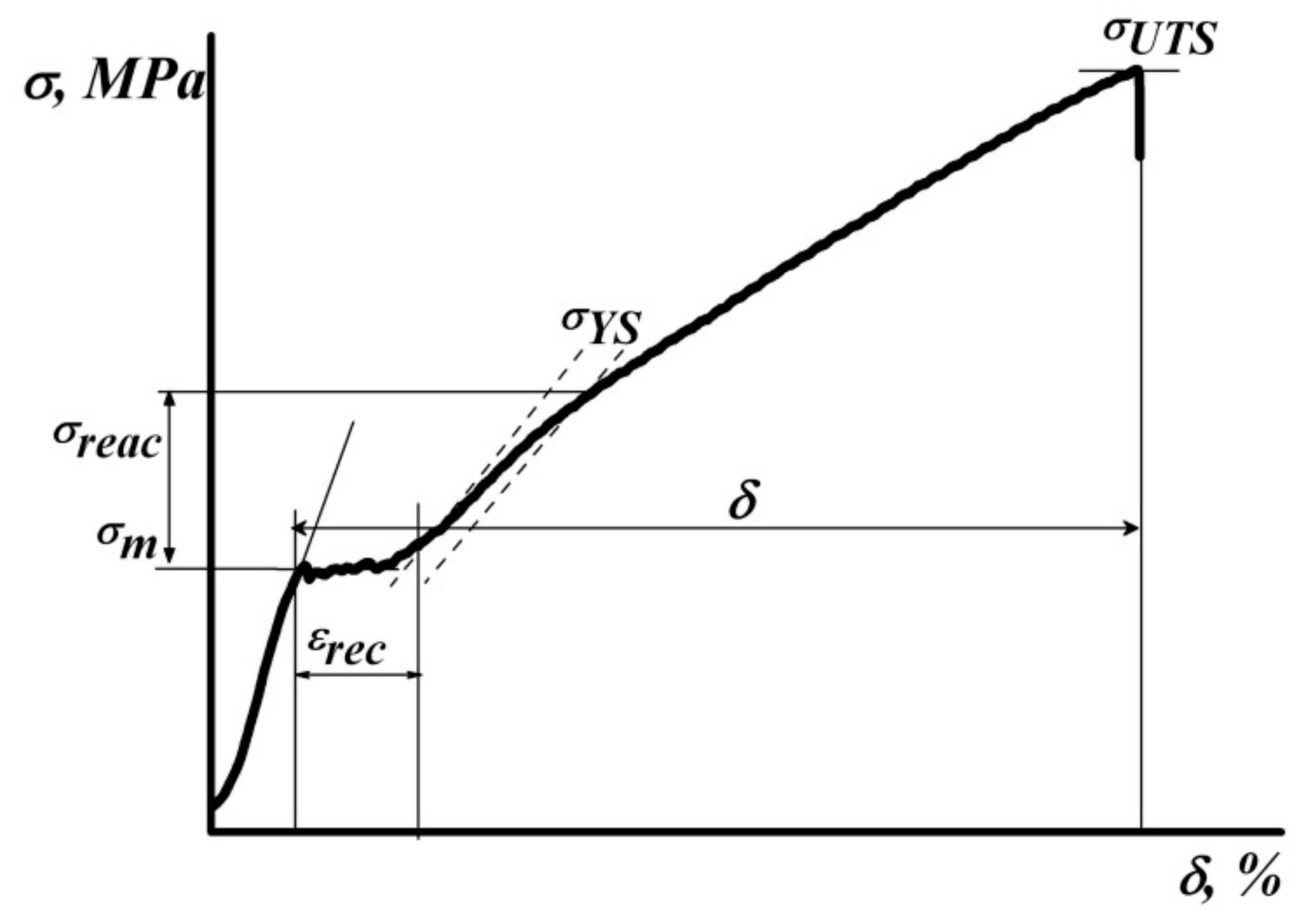


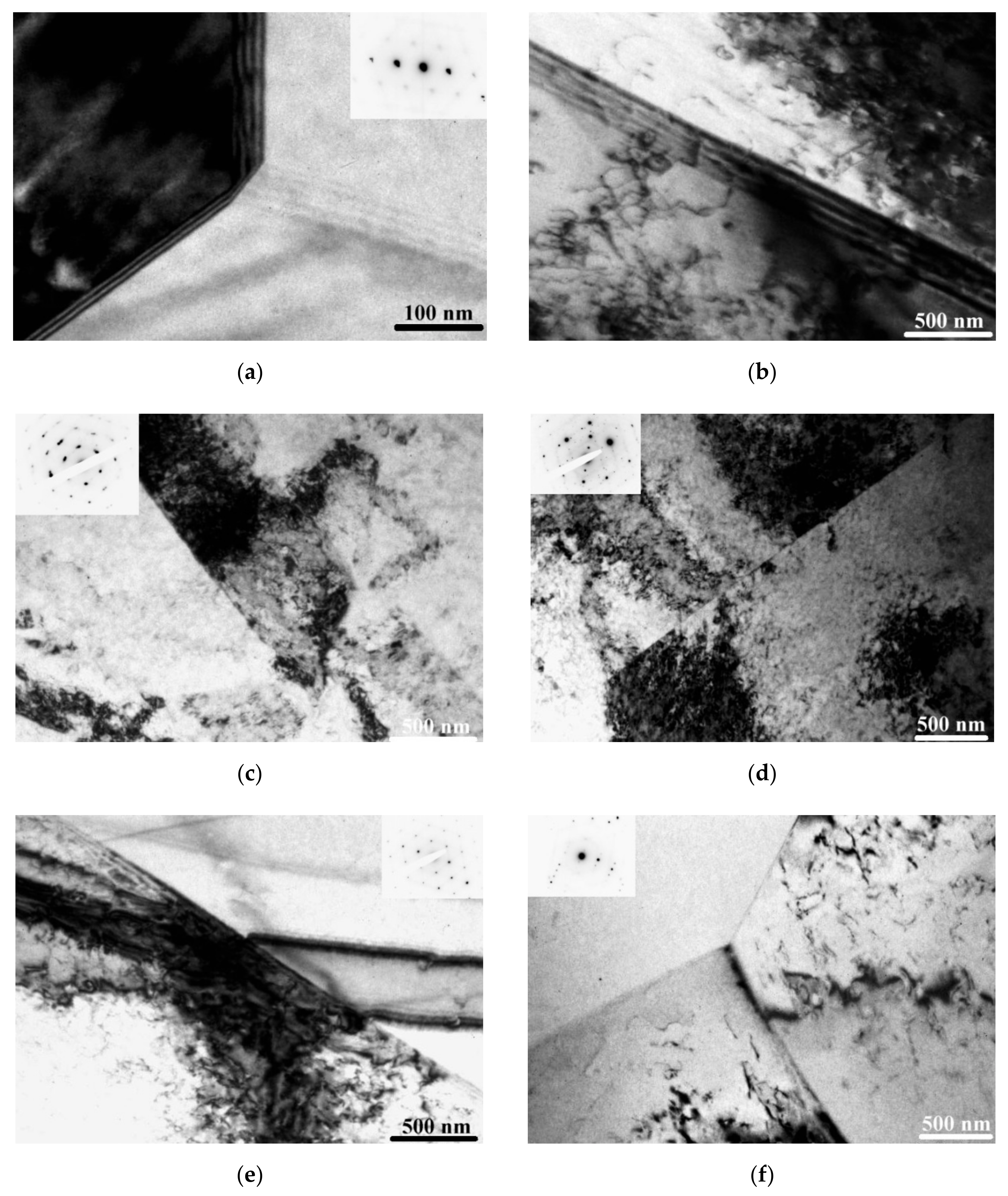
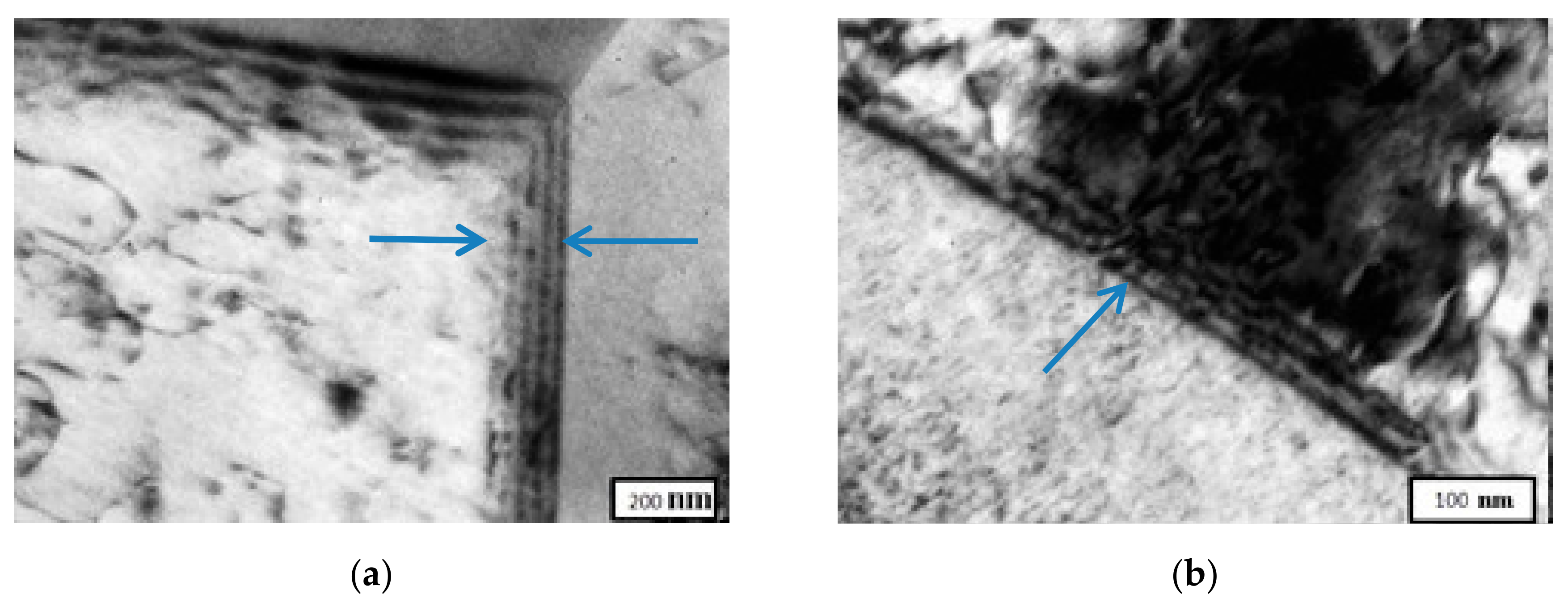

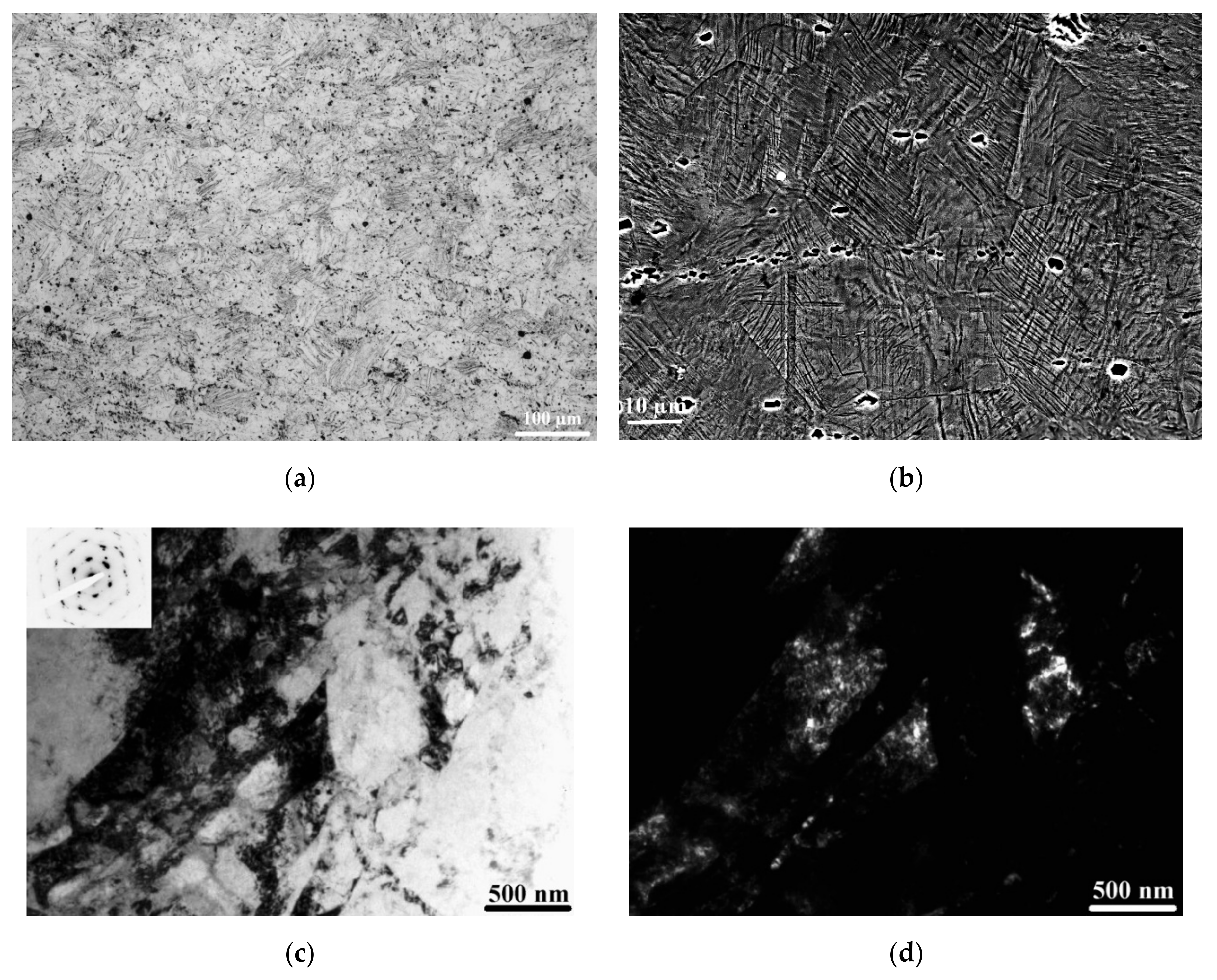
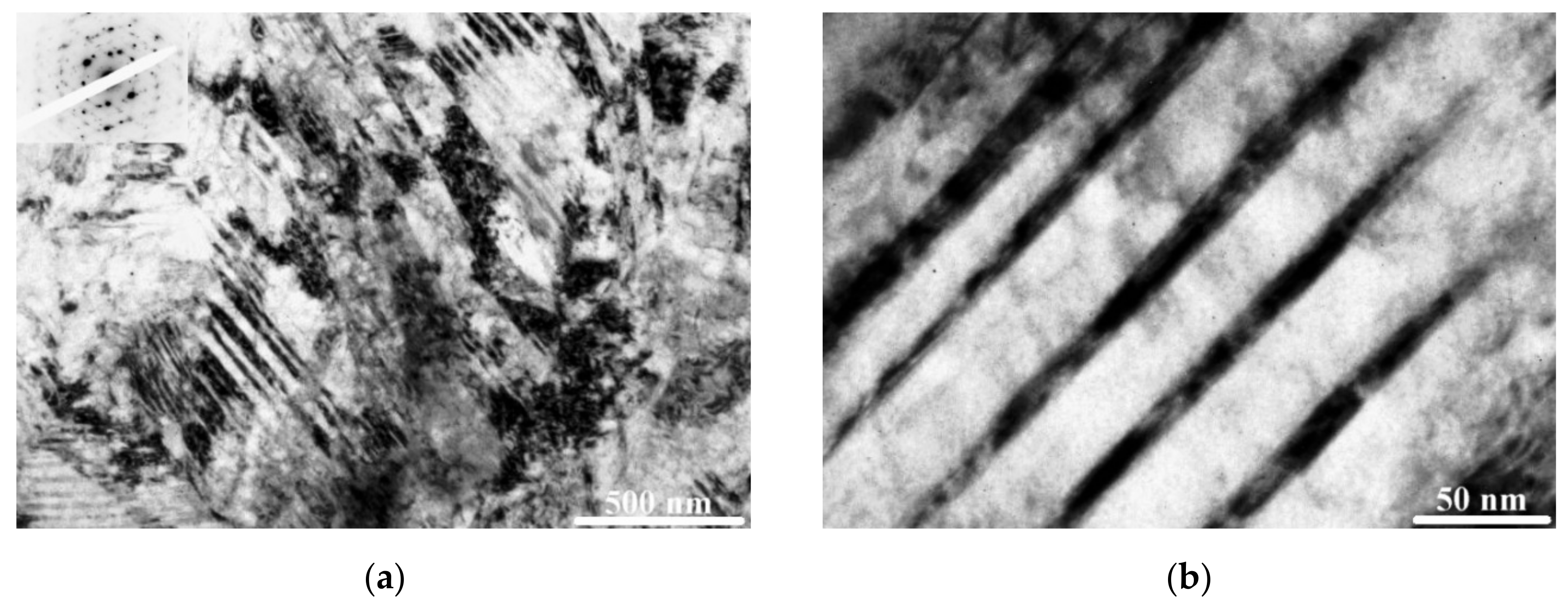
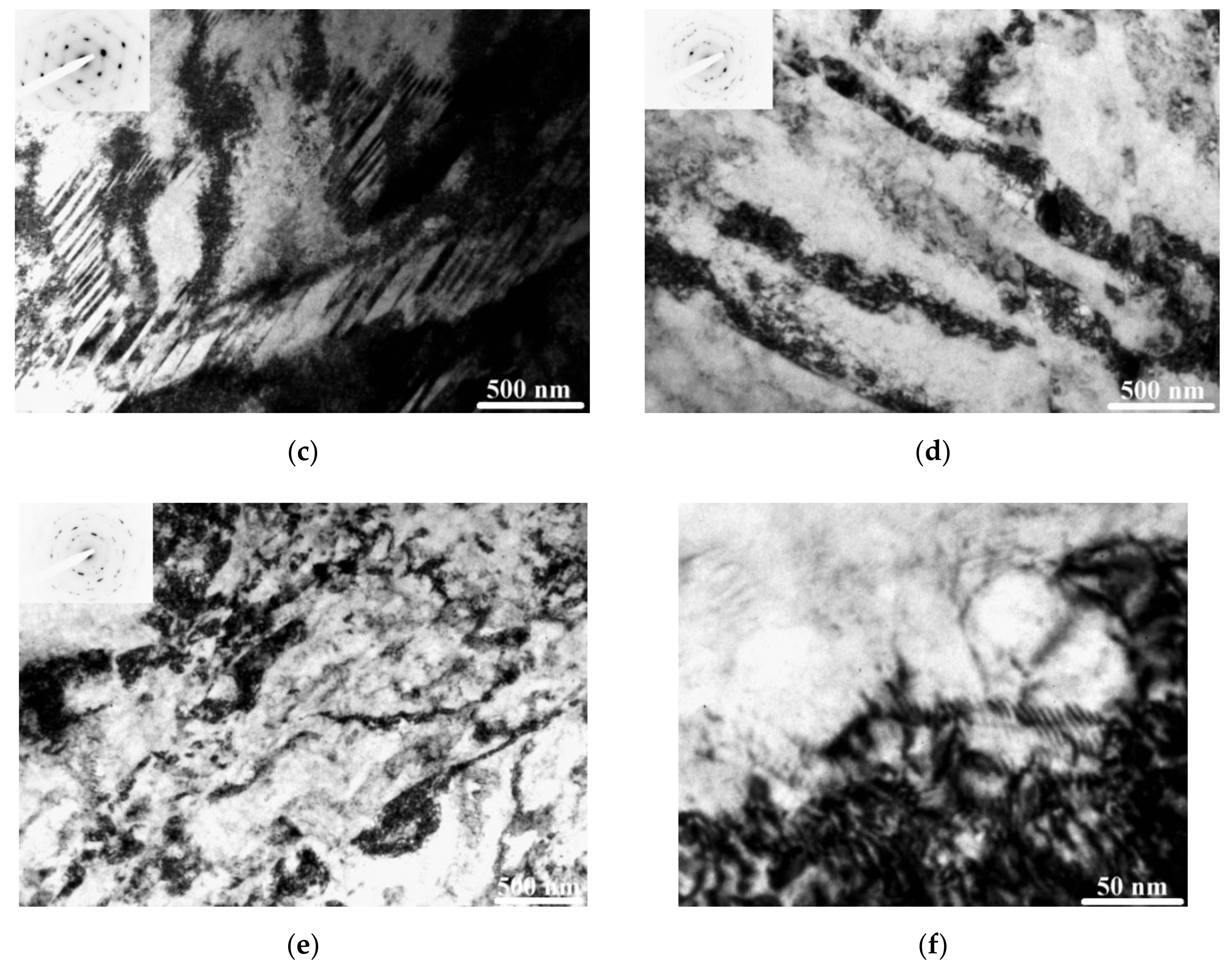

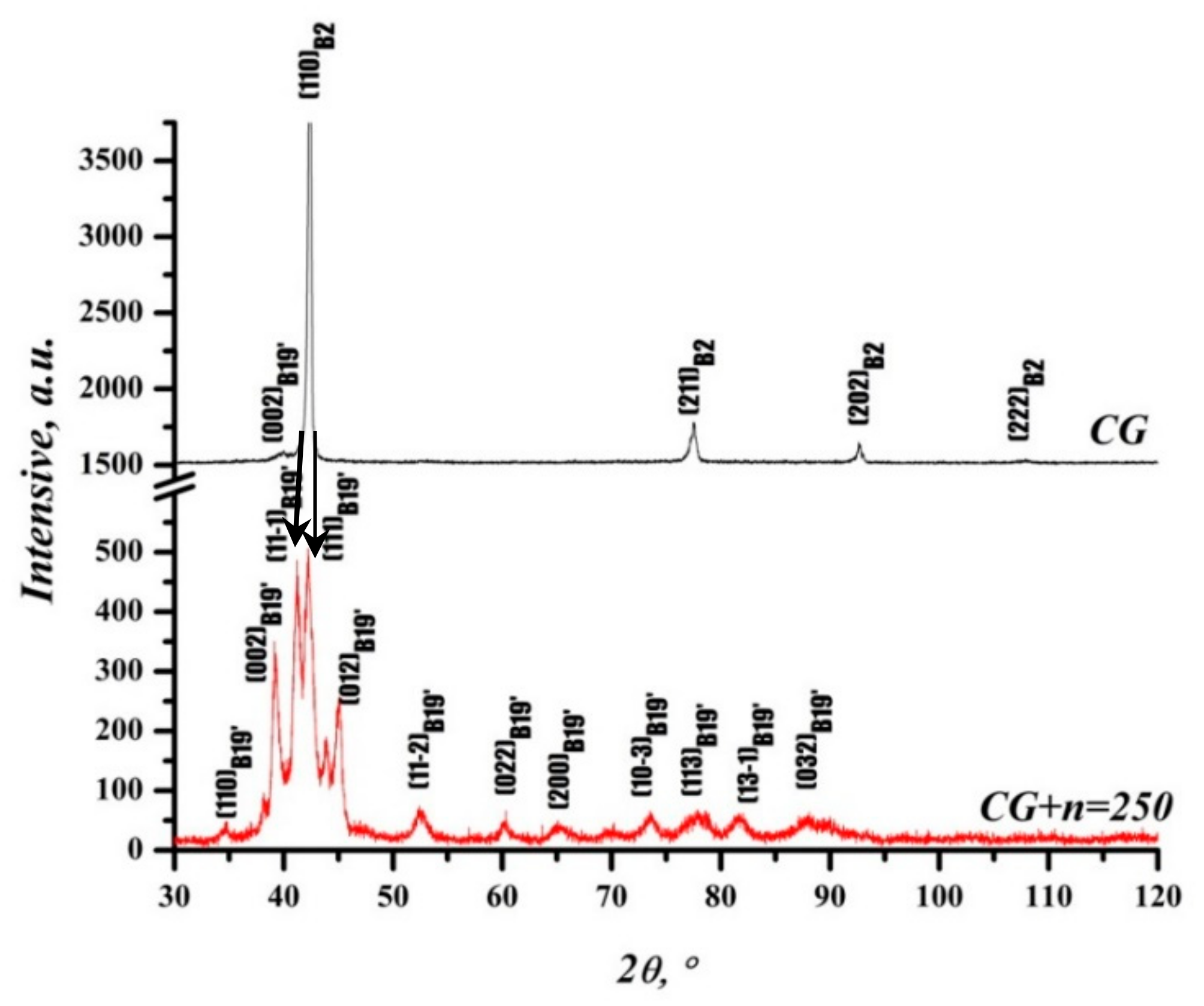
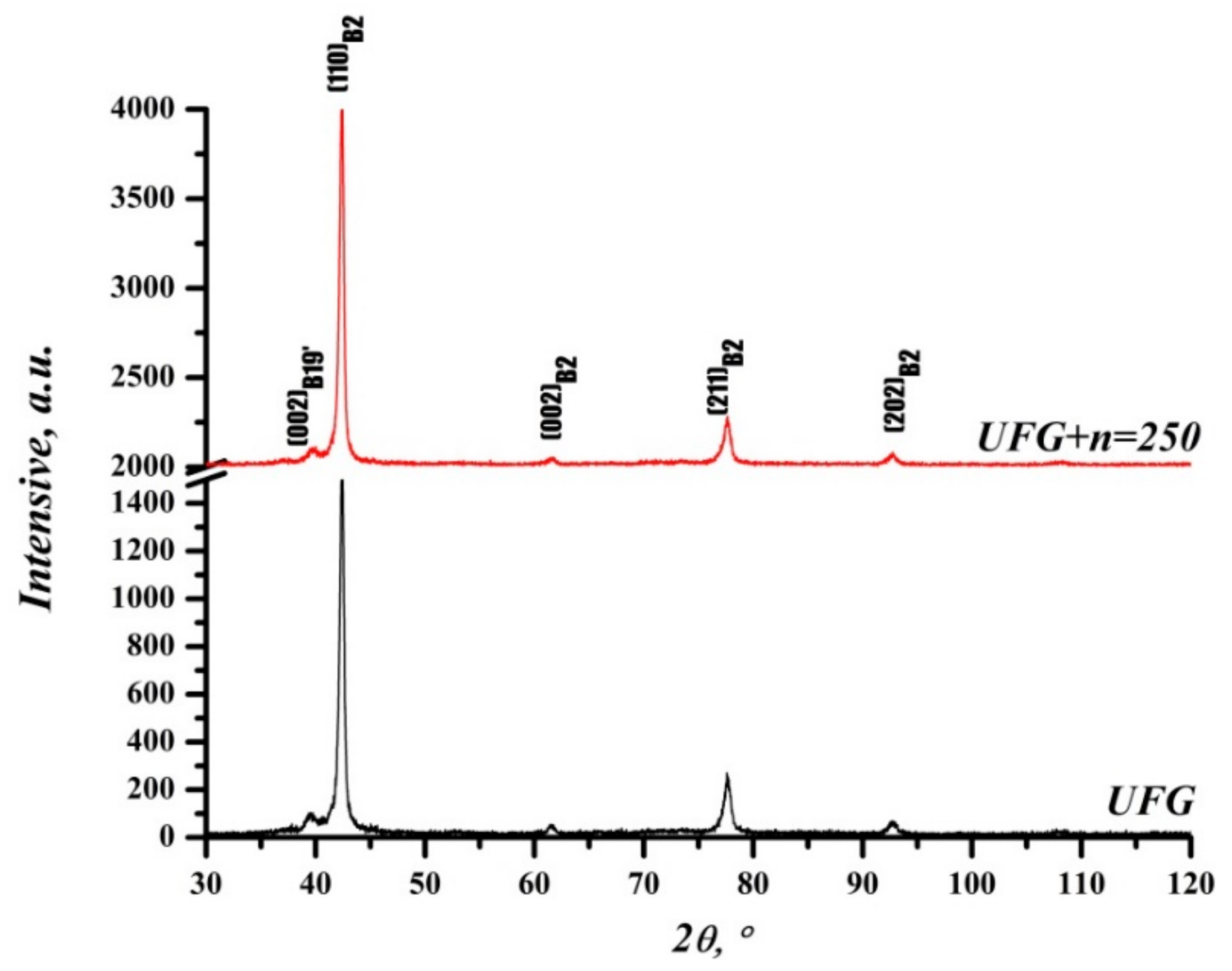
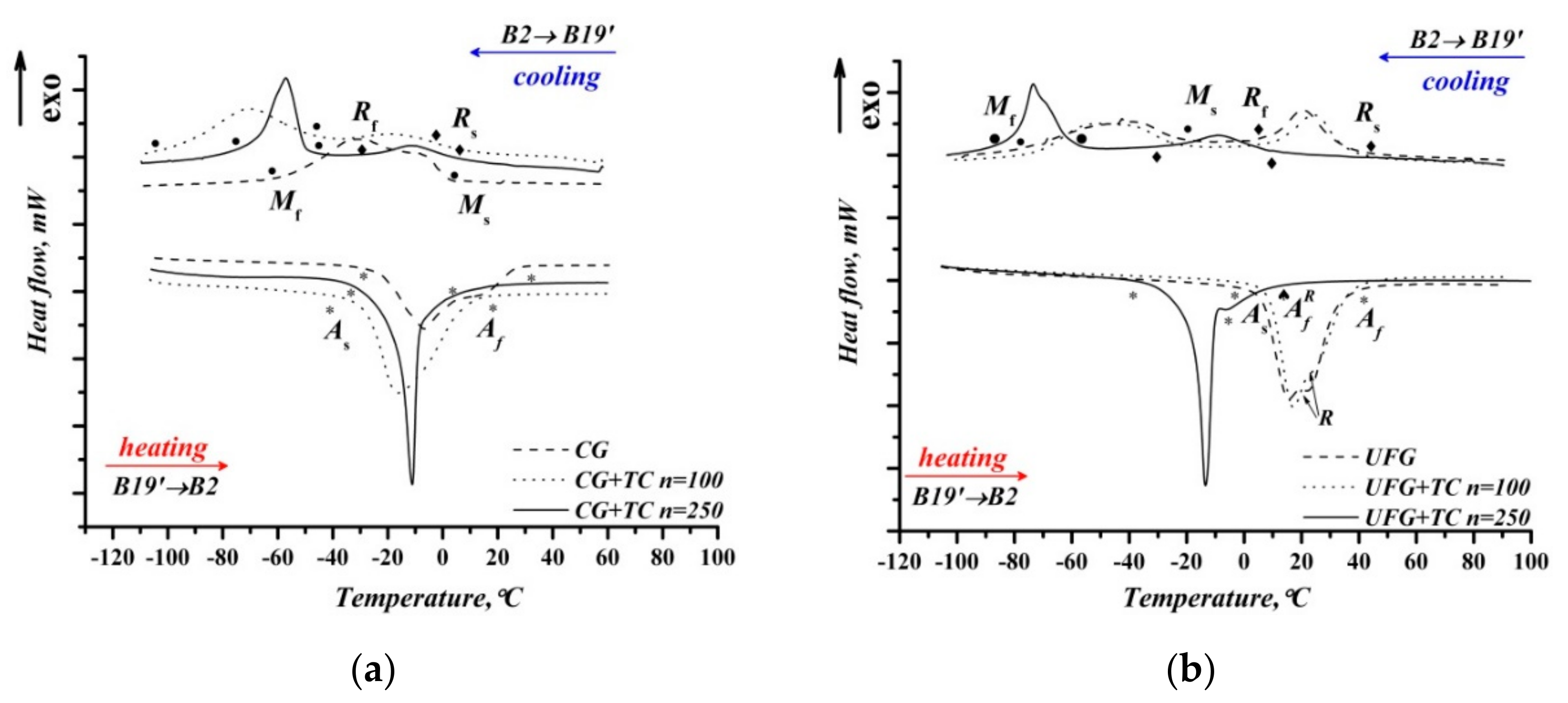
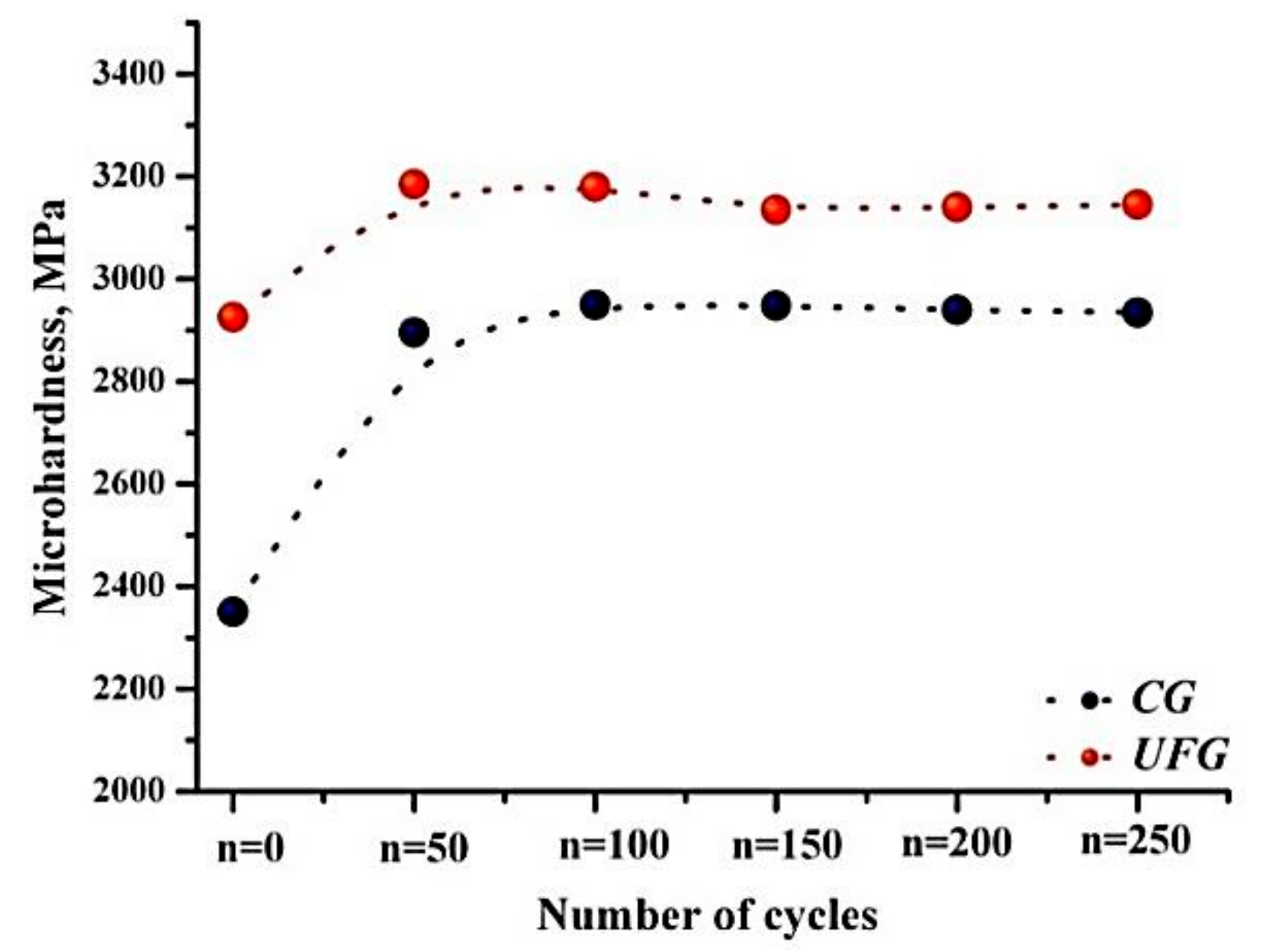
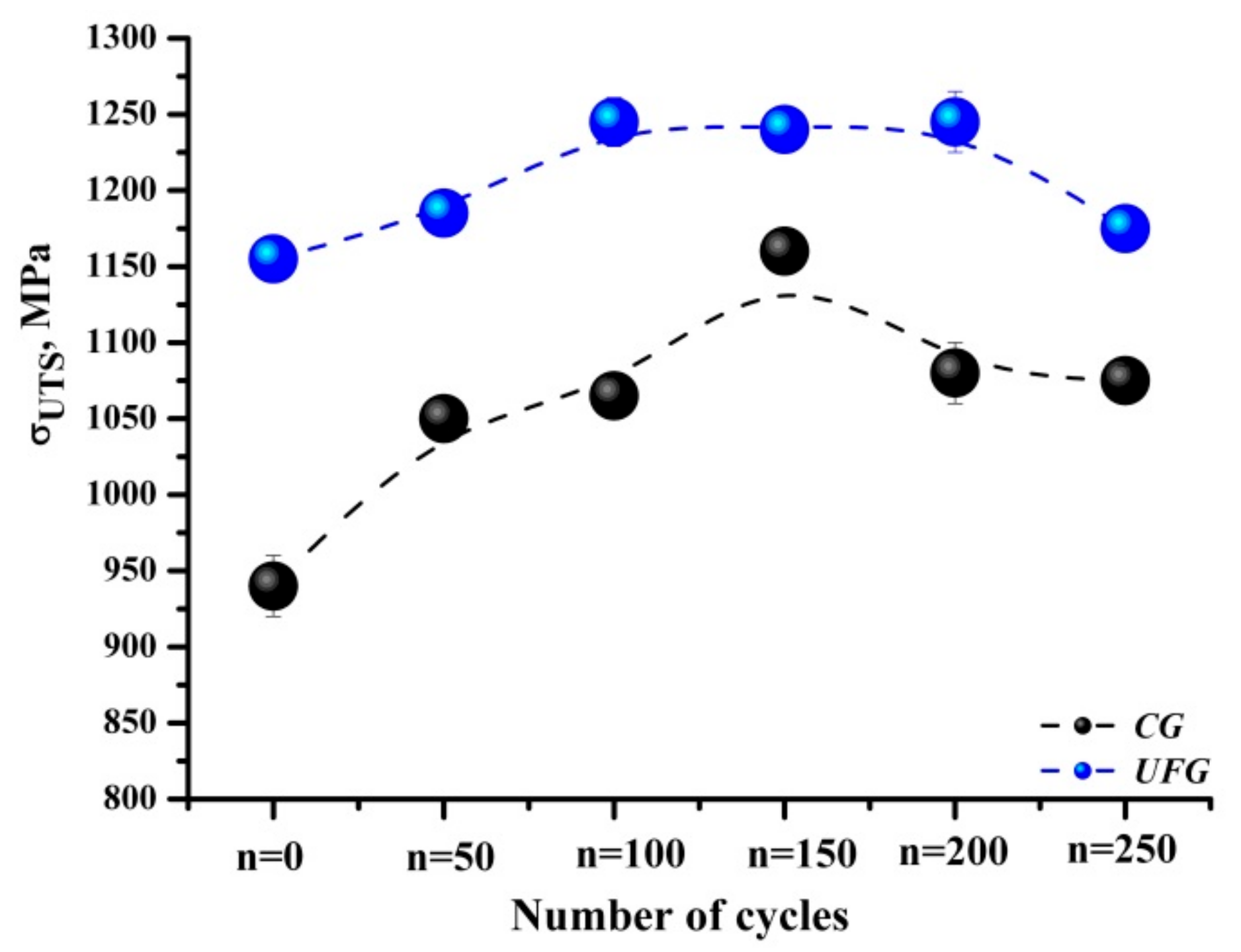


| Main Elements | Impurity | ||||||||
|---|---|---|---|---|---|---|---|---|---|
| Ni | Ti | Fe | Si | C | N | O | H | Co | Remainder |
| 50.8 | Remainder | 0.27 | 0.13 | 0.09 | 0.04 | 0.18 | 0.012 | - | 0.27 |
| State | Parameters of Structure | |||
|---|---|---|---|---|
| Parameter Lattice a, Å | CSR, nm | <ε2>1/2 × 10−4 | ρ × 1015, m−2 | |
| CG | 3.013 ± 0.001 | 97 ± 2 | 0.8 ± 0.1 | 0.5 ± 0.1 |
| CG + TC | 2.895 ± 0.001 (monoclinic) | 37 ± 2 | 2.2 ± 0.1 | 1.6 ± 0.1 |
| Δ | 0.118 | 60 | 1.4 | 1.1 |
| UFG | 3.011 ± 0.003 | 35 ± 3 | 2.7 ± 0.1 | 5.3 ± 0.15 |
| UFG + TC | 3.013 ± 0.001 | 19 ± 2 | 3.4 ± 0.1 | 7.1 ± 0.1 |
| Δ | 0.002 | 16 | 0.7 | 1.8 |
| States | Number of Cycles | Ms, °C | Mf, °C | Rs, °C | Rf, °C | As, °C | Af, °C | AfR, °C |
|---|---|---|---|---|---|---|---|---|
| CG | n = 0 | 3.07 | −60.11 | - | - | −25.07 | 26.83 | - |
| n = 100 | −38.60 | −98.32 | 8.46 | - | −29.55 | 8.47 | - | |
| n = 250 | −49.63 | −70.23 | 11.62 | −29.5 | −18.33 | −8.14 | - | |
| UFG | n = 0 | −13.52 | −80.96 | 39.44 | 2.18 | 6.11 | 33.16 | - |
| n = 100 | −16.98 | −74.27 | 38.60 | 2.24 | 7.83 | 36.65 | - | |
| n = 250 | −59.72 | −83.09 | 15.10 | −32.07 | −19.87 | −9.87 | 7.97 |
© 2020 by the authors. Licensee MDPI, Basel, Switzerland. This article is an open access article distributed under the terms and conditions of the Creative Commons Attribution (CC BY) license (http://creativecommons.org/licenses/by/4.0/).
Share and Cite
Churakova, A.; Gunderov, D. Microstructural and Mechanical Stability of a Ti-50.8 at.% Ni Shape Memory Alloy Achieved by Thermal Cycling with a Large Number of Cycles. Metals 2020, 10, 227. https://doi.org/10.3390/met10020227
Churakova A, Gunderov D. Microstructural and Mechanical Stability of a Ti-50.8 at.% Ni Shape Memory Alloy Achieved by Thermal Cycling with a Large Number of Cycles. Metals. 2020; 10(2):227. https://doi.org/10.3390/met10020227
Chicago/Turabian StyleChurakova, Anna, and Dmitry Gunderov. 2020. "Microstructural and Mechanical Stability of a Ti-50.8 at.% Ni Shape Memory Alloy Achieved by Thermal Cycling with a Large Number of Cycles" Metals 10, no. 2: 227. https://doi.org/10.3390/met10020227
APA StyleChurakova, A., & Gunderov, D. (2020). Microstructural and Mechanical Stability of a Ti-50.8 at.% Ni Shape Memory Alloy Achieved by Thermal Cycling with a Large Number of Cycles. Metals, 10(2), 227. https://doi.org/10.3390/met10020227







